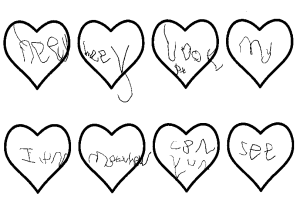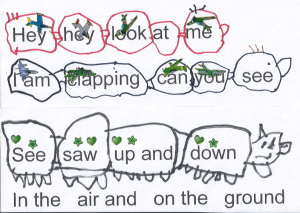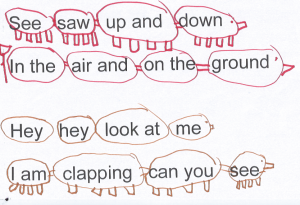For the students who’ve completed their red Key Skills star on the Express Yourself Piano Star Scheme it’s now time for orange!! I hand them their orange Initial star and they proudly stick it to my music room wall.
In the Express Yourself Piano Star Scheme the stars are colour coded and go up by level. The orange Initial star is the third in the scheme and it is for students who have finished their Level 1 tutor book. Depending on their playing level you may be in the early stages of preparation for an Initial level. Exams at this level include Trinity Initial, LCM Step 1 or 2, ABRSM Prep Test, Trinity Rock and Pop Initial, and Rockschool Debut. It’s such a minefield of information so here is a blog post briefly covering exams.
So what do I include at Initial Level?
Pitch
There are lots of different songs in Jolly Music that just use two or three pitches. They start with so and mi, then add la or do. Many you will recognise from childhood, some you won’t. Other sources of songs with these pitches are Songs for Singing & Musicianship Training by David and Yuko Vinden. Along with arm movements, with or without the solfa hand signs, the students develop their idea of high and low pitches. Once they’ve learnt several of these songs, I challenge them to write their own with their own lyrics. They can sing it first and then work it out on the piano using black keys, or vice versa.
To help the students sing the final tonic note of a melody I often play their pieces and don’t play the final note. The student then has to sing the note. It is important to establish the comfort range of the student and then ensure the final note sits within this range. If not, then the student may have difficulty pitching it.
Learning outcomes for pitch
- The student can play known do-mi-so-la songs by ear
- The student can echo (singing or playing) short do-mi-so-la patterns with solfa hand signs
- The student can identify if two melodies are the same or different
- The student can identify which of three pitches is the highest or lowest
- The student can sing the final tonic note from their pieces, songs or a new melody
- The student can transpose a memorised piece (no black notes) for example Star Wars
Pulse and rhythm
The excellent musicianship scheme Go for Bronze has taught me a great new way of clapping the pulse. I had always clapped, and used a louder clap for the first beat of the bar. But in Go for Bronze they clap and click. The clap comes on the first beat of the bar and the clicks on the other beats. If the student can’t click they can always tap their knees instead. It works so well because there’s more movement so they can really feel the difference between the beats. And as a teacher you can see they’ve got the hang of it!
Learning outcomes for pulse and rhythm
- The student can clap or clap and click a steady beat in three time and four time
- The student can track written music being played by their teacher
- The student can echo a simple rhythm
- The student can clap the rhythm of a familiar piece and march the pulse at the same time
- The student can create rhythm pictures of known songs and translate them into stick notation
- The student knows the rhythm names for ta and te te and can read stick notation
Dynamics and articulation
At this stage students should be refining their dynamic control, and also their memory! Hopefully at this point you won’t need to remind them beforehand, or use the high frequency phrase “That was lovely Jimmy, now try with …”! They will also have started working on staccato and legato. Some students will have been playing legato automatically, but those who have been playing detached will now need to learn two new techniques.
Learning outcomes for dynamics and articulation
- The student can identify, by listening, whether a melody is played forte (loud) or piano (soft)
- The student can identify, by listening, whether a melody is played mostly staccato or legato
- The student plays their pieces with some dynamics and articualation without reminders
Technique
You may have noticed that there isn’t a technique point on the star charts. This is because technique is an ongoing journey. It’s harder to “tick it off”. My students aren’t aware that there are milestones to achieve. Where appropriate I do give them temporary targets. We can cover technique issues through repertoire and technique exercises from their Piano Adventures Technique & Artistry books. However I also use scales exercises to practise technique.
Learning outcomes for technique
- The student knows that they should play with a rounded hand shape
- The student knows that they should play using their fingertips and side edge of their thumb
- The student knows that they should play with a relaxed wrist
- The student knows that they should play staccato with a light hand bounce
- The student knows that their fingers and thumbs should play evenly
Scales and chords
At Initial level the student will learn the same five note scale and arpeggio patterns as before, but now including minor keys and hands together. As I mentioned in the technique section these patterns can be used for so many things. They can play them staccato or legato to help with articulation control. They can play them forte or piano for improved dynamics. You can target hand position issues.
At this level I introduce the standard octave fingering for C major and A natural minor and also teach the octave chromatic scale. I find teaching the chromatic scale in contrary motion can help with fingering. First we learn them in one direction, outwards from D. This is by far the easiest direction as you don’t have to remember whether it’s a thumb white note or a finger 2 white note. Once that’s fully understood we add the inwards direction. Still hands separately. Of course we could teach C and Am in contrary motion too, to ensure the fingering in each hand matches. You will need to judge that on a case by case basis but on the whole I use similar motion for diatonic scales.
Learning outcomes for scales
- The student can play a pentachord scale and triad in the major keys of C, D, E, F, G and A, and the minor keys of Am, Dm and Em, hands together
- The student can play an octave scale in the keys of C major and A natural minor hands separately
- The student can play a chromatic scale in contrary motion from D hands separately
- The student can identify a pentachord scale or triad as major or minor by listening
Theory
At this point many of my students are working on Ying Ying Ng’s Music Theory for Young Children Book 2. It introduces quavers and expands the known note range. The main sticking point for students at this point is their speed of response for note reading. Learning how to use FACE and All Cows Eat Grass is really beneficial but there are only so many worksheets we can produce. Using online note reading games can really help the students with their reading – see my blog post on the subject.
Learning outcomes for theory
- The student knows Middle C (C4) to C5 in the treble clef and C3 to Middle C in the bass clef
- The student understands FACE and All Cows Eat Grass
- The student understands quavers and their rests
- The student understands tones, semitones, sharps and flats (but not as key signatures)
- The student can notate the rhythm of known songs as stick notation
Sight Reading
Sight reading material will be dependent on the level of the student’s repertoire. We want the sight reading to be much easier than the student’s main pieces. Resources I use at this level are Improve Your Sight Reading Pre Grade 1 and Sound at Sight Book 1. However if the student isn’t quite ready, the solfa work on pitch and rhythm helps lay the groundwork for sight singing and sight reading.
Learning outcome for Sight Reading
- The student is competent at the sight reading examples for Trinity Initial
Improvisation and Composition
My main aim is for students to give improvisation and composition a good go. We will do a number of activities to practise. These include compositions based on their pieces, especially blues-based songs; more work with the Scales, Patterns and Improvs Book; creating answers to short musical questions on the black keys or using solfa; creating melodies from do-so baselines and adding do-so baselines to melodies.
Learning outcomes for Improvisation and Composition
- The student has made a good attempt at composition
- The student has made a good attempt at improvisation
What’s next?
Once the student has gained a sticker on each point on their orange Initial star they get to keep their completed star. They also get a certificate and a report which shows how they’ve progressed over the period and a summary of all the skills they’ve gained. A great milestone on the journey to Grade 1 to show they are progressing. Many of the children take them into school and have them awarded in assembly in the same way as other children have swimming badges and karate certificates.
They then get their yellow Level 1 star to stick on my music room wall. The learning outcomes for Level 1 will be a topic for a future blog post.
Have I missed anything? Why not add a comment!




